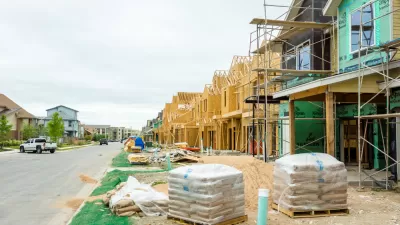Australia's housing market has built steadily at market rates but housing affordability has remained steady. What if building waves of new supply isn't enough to improve affordable housing options for those in need?

An article with a small committee of writers, and published by The Conversation, aims to debunk policy clichés "that keep reemerging" in the face of Australia's affordable housing shortage.
To put it simply, this article is taking aim at supply side approaches to housing policy—i.e., loosening zoning to allow for more building. In Australia, according to this article, supply is booming, but that hasn't helped lower housing costs.
Australia’s new housing supply per capita is actually very strong by international standards. Over the past decade, supply of new units and apartments has been flowing in job-rich metropolitan areas with dense populations, which are also higher-value locations.
According to the cliché, this supply response should have cooled prices. Yet dwelling price inflation has surged even in metropolitan areas where new housing supply has exceeded population growth.
The article also takes aim at the notion of filtering, "whereby older housing moves down to the affordable end of the market over time." The authors claim that the evidence for filtering is thin in the United States. As for in Australia: "in Australia there’s still no evidence to suggest new housing supply has filtered across the housing stock to expand affordable housing opportunities for low-income Australians, or that it will do so any time soon."
The authors also argue that builders would stop building as soon as prices did cool, so "high levels of supply output are rarely sustained." All of these arguments lead to the conclusion that planning reform is inadequate as affordable housing strategy. The only solution, according to the article, is a larger affordable housing sector.
FULL STORY: Affordable housing policy failure still being fuelled by flawed analysis

Alabama: Trump Terminates Settlements for Black Communities Harmed By Raw Sewage
Trump deemed the landmark civil rights agreement “illegal DEI and environmental justice policy.”

Planetizen Federal Action Tracker
A weekly monitor of how Trump’s orders and actions are impacting planners and planning in America.

The 120 Year Old Tiny Home Villages That Sheltered San Francisco’s Earthquake Refugees
More than a century ago, San Francisco mobilized to house thousands of residents displaced by the 1906 earthquake. Could their strategy offer a model for the present?

Ken Jennings Launches Transit Web Series
The Jeopardy champ wants you to ride public transit.

BLM To Rescind Public Lands Rule
The change will downgrade conservation, once again putting federal land at risk for mining and other extractive uses.

Indy Neighborhood Group Builds Temporary Multi-Use Path
Community members, aided in part by funding from the city, repurposed a vehicle lane to create a protected bike and pedestrian path for the summer season.
Urban Design for Planners 1: Software Tools
This six-course series explores essential urban design concepts using open source software and equips planners with the tools they need to participate fully in the urban design process.
Planning for Universal Design
Learn the tools for implementing Universal Design in planning regulations.
Clanton & Associates, Inc.
Jessamine County Fiscal Court
Institute for Housing and Urban Development Studies (IHS)
City of Grandview
Harvard GSD Executive Education
Toledo-Lucas County Plan Commissions
Salt Lake City
NYU Wagner Graduate School of Public Service





























